Estimating the Risk of Acute Gastrointestinal Disease Attributed to E. coli O157:H7 in Irrigation Water and Agricultural Soil: A Quantitative Microbial Risk Assessment
Abstract
:1. Introduction
2. Materials and Methods
2.1. Study Setting
2.2. Microbiological Analysis
2.3. Quantitative Microbial Risk Modelling
2.3.1. Hazard Identification
2.3.2. Hazard Characterization
2.3.3. Exposure Assessment
2.3.4. Risk Characterization
3. Results
3.1. The Concentration and Identification of E. coli O157:H7 in the Samples
3.2. Dose Modelling and Hazard Characterization
3.3. Exposure Assessment
3.4. Risk Characterization
4. Discussion
5. Study Limitations
6. Conclusions
Author Contributions
Funding
Institutional Review Board Statement
Informed Consent Statement
Conflicts of Interest
References
- Cook, K.L.; Givan, E.C.; Mayton, H.M.; Parekh, R.R.; Taylor, R.; Walker, S.L. Using the agricultural environment to select better surrogates for foodborne pathogens associated with fresh produce. Int. J. Food Microbiol. 2017, 262, 80–88. [Google Scholar] [CrossRef] [PubMed]
- Murray, K.; Wu, F.; Shi, J.; Xue, S.J.; Warriner, K. Challenges in the microbiological food safety of fresh produce: Limitations of post-harvest washing and the need for alternative interventions. Food Qual. Saf. 2017, 1, 289–301. [Google Scholar] [CrossRef] [Green Version]
- Steele, M.; Odumeru, J. Irrigation water as source of foodborne pathogens on fruit and vegetables. J. Food Prot. 2004, 67, 2839–2849. [Google Scholar] [CrossRef]
- Jongman, M.; Korsten, L. Irrigation water quality and microbial safety of leafy greens in different vegetable production systems: A review. Food Rev. Int. 2018, 34, 308–328. [Google Scholar] [CrossRef] [Green Version]
- Islam, M.; Morgan, J.; Doyle, M.P.; Phatak, S.C.; Millner, P.; Jiang, X. Persistence of Salmonella enterica Serovar Typhimurium on Lettuce and Parsley and in Soils on Which They Were Grown in Fields Treated with Contaminated Manure Composts or Irrigation Water. Foodborne Pathog. Dis. 2004, 1, 27–35. [Google Scholar] [CrossRef]
- Al-Ajmi, D.; Rahman, S.; Banu, S. Occurrence, virulence genes, and antimicrobial profiles of Escherichia coli O157 isolated from ruminants slaughtered in Al Ain, United Arab Emirates. BMC Microbiol. 2020, 20, 210. [Google Scholar] [CrossRef] [PubMed]
- Iwu, C.D.; du Plessis, E.; Korsten, L.; Okoh, A.I. Prevalence of Escherichia coli O157:H7 strains in irrigation water and agricultural soil in two district municipalities in South Africa. Int. J. Environ. Stud. 2020, 78, 474–483. [Google Scholar] [CrossRef]
- Iwu, C.D.; Okoh, A.I. Characterization of antibiogram fingerprints in Listeria monocytogenes recovered from irrigation water and agricultural soil samples. PLoS ONE 2020, 15, e0228956. [Google Scholar] [CrossRef] [Green Version]
- Iwu, C.D.; du Plessis, E.M.; Korsten, L.; Nontongana, N.; Okoh, A.I. Antibiogram Signatures of Some Enterobacteria Recovered from Irrigation Water and Agricultural Soil in two District Municipalities of South Africa. Microorganisms 2020, 8, 1206. [Google Scholar] [CrossRef]
- Erickson, M.C.; Webb, C.C.; Davey, L.E.; Payton, A.S.; Flitcroft, I.D.; Doyle, M. Internalization and Fate of Escherichia coli O157:H7 in Leafy Green Phyllosphere Tissue Using Various Spray Conditions. J. Food Prot. 2014, 77, 713–721. [Google Scholar] [CrossRef]
- Njie, C.; Carlos, C. International Journal of Food Microbiology Characterisation of Escherichia coli O157 strains from humans, cattle and pigs in the North–West Province, South Africa. Int. J. Food Microbiol. 2008, 128, 181–188. [Google Scholar] [CrossRef]
- Ibekwe, A.M.; Papiernik, S.K.; Grieve, C.M.; Yang, C.H. Quantification of persistence of Escherichia coli O157:H7 in contrasting soils. Int. J. Microbiol. 2011, 2011, 421379. [Google Scholar] [CrossRef] [Green Version]
- Lupindu, A.M. Epidemiology of Shiga toxin-producing Escherichia coli O157:H7 in Africa in review. S. Afr. J. Infect. Dis. 2018, 33, 24–30. [Google Scholar] [CrossRef]
- Geronimo Portable Device Can Detect Escherichia coli in 20 Min.—NYU Abu Dhabi. Available online: https://nyuad.nyu.edu/en/news/latest-news/science-and-technology/2017/november/portable-device-can-detect-e-coli-in-20-minutes.html (accessed on 21 January 2021).
- World Health Organization. Quantitative Microbial Risk Assessment: Application for Water Safety Management. Available online: http://www.who.int/water_sanitation_health/publications/qmra/en/ (accessed on 25 April 2018).
- ECSECC Eastern Cape Socio Economic Consultative Council. Amathole District Municipality Socio Economic Review and Outlook, 2017; ECSECC: Vincent, Italy, 2017. [Google Scholar]
- CHDM. About Us—Chris Hani District Municipality. Available online: https://www.chrishanidm.gov.za/municipality/about-us/ (accessed on 30 January 2021).
- Wang, G.; Clark, C.G.; Rodgers, F.G. Detection in Escherichia coli of the genes encoding the major virulence factors, the genes defining the O157:H7 serotype, and components of the type 2 Shiga toxin family by multiplex PCR. J. Clin. Microbiol. 2002, 40, 3613–3619. [Google Scholar] [CrossRef] [Green Version]
- Paton, A.W.; Paton, J.C. Detection and Characterization of Shiga Toxigenic Escherichia coli by Using Multiplex PCR Assays for stx 1, stx 2, eaeA, Enterohemorrhagic Escherichia coli hlyA, rfb O111, and rfb O157. J. Clin. Microbiol. 1998, 36, 598–602. [Google Scholar] [CrossRef] [Green Version]
- Rahal, E.A.; Kazzi, N.; Nassar, F.J.; Matar, G.M. Escherichia coli O157:H7—Clinical aspects and novel treatment approaches. Front. Cell. Infect. Microbiol. 2012, 2, 138. [Google Scholar] [CrossRef] [PubMed] [Green Version]
- Nazemi, A.; Mirinargasi, M.; Khataminezhad, M.R.; Shokouhi Mostafavi, S.K.; Sharifi, S.H. Detection of stx1, stx2, LT and ST toxin genes and O157 and H7 antigen genes among uropathogenic Escherichia coli isolates from Iran. Afr. J. Microbiol. Res. 2012, 6, 867–869. [Google Scholar] [CrossRef]
- CAC Codex Alimentarius Commission. Principles and Guidelines for the Conduct of Microbiological Risk Management (MRM). Available online: http://www.fao.org/docrep/004/y1579e/y1579e05.htm (accessed on 26 April 2018).
- Haas, C.N.; Rose, J.B.; Gerba, C.P. Quantitative Microbial Risk Assessment; John Wiley & Sons, Inc.: New York, NY, USA, 1999; ISBN 9780471183976. [Google Scholar]
- Kouamé, P.K.; Nguyen-viet, H.; Dongo, K.; Zurbrügg, C.; Biémi, J.; Bonfoh, B. Microbiological risk infection assessment using QMRA in agriculture systems in Côte d’ Ivoire, West Africa. Environ. Monit. Assess. 2017, 189, 587. [Google Scholar] [CrossRef] [Green Version]
- Mok, H.-F.; Barker, S.F.; Hamilton, A.J. A probabilistic quantitative microbial risk assessment model of norovirus disease burden from wastewater irrigation of vegetables in Shepparton, Australia. Water Res. 2014, 54, 347–362. [Google Scholar] [CrossRef] [PubMed]
- Balderrama-Carmona, A.P.; Gortáres-Moroyoqui, P.; Álvarez-Valencia, L.H.; Castro-Espinoza, L.; Mondaca-Fernández, I.; Balderas-Cortés, J.d.J.; Chaidez-Quiroz, C.; Meza-Montenegro, M.M. Occurrence and quantitative microbial risk assessment of Cryptosporidium and Giardia in soil and air samples. Int. J. Infect. Dis. 2014, 26, 123–127. [Google Scholar] [CrossRef] [Green Version]
- Shuval, H.; Lampert, Y.; Fattal, B. Development of a risk assessment approach for evaluating wastewater reuse standards for agriculture. Water Sci. Technol. 1997, 35, 15–20. [Google Scholar] [CrossRef]
- United States Environmental Protection Agency. Exposure Factors Handbook (1997, Final Report); EPA/600/P-95/002F a–c; U.S. Environmental Protection Agency: Washington, DC, USA, 1997.
- Howard, G.; Pedley, S.; Tibatemwa, S. Quantitative microbial risk assessment to estimate health risks attributable to water supply: Can the technique be applied in developing countries with limited data? J. Water Health 2006, 4, 49–65. [Google Scholar] [CrossRef] [PubMed]
- Haas, C.N. Quantitative Microbial Risk Assessment and Molecular Biology: Paths to Integration. Environ. Sci. Technol. 2020, 54, 8539–8546. [Google Scholar] [CrossRef]
- Yapo, R.I.; Koné, B.; Bonfoh, B.; Cissé, G.; Zinsstag, J.; Nguyen-Viet, H. Quantitative microbial risk assessment related to urban wastewater and lagoon water reuse in Abidjan, Côte d’Ivoire. J. Water Health 2014, 12, 301–309. [Google Scholar] [CrossRef]
- DWAF, Department of Water Affairs and Forestry. South African Water Quality Guidelines. Domest. Water Use 2012, 1, 1–197. [Google Scholar]
- WHO, World Health Organization. Health Guidelines for the Use of Wastewater in Agriculture and Aquaculture. Available online: https://apps.who.int/iris/bitstream/handle/10665/39401/WHO_TRS_778.pdf?sequence=1&isAllowed=y (accessed on 3 June 2020).
- Doane, C.A.; Pangloli, P.; Richards, H.A.; Mount, J.R.; Golden, D.A.; Draughon, F.A. Occurrence of Escherichia coli O157:H7 in diverse farm environments. J. Food Prot. 2007, 70, 6–10. [Google Scholar] [CrossRef]
- Park, S.; Szonyi, B.; Gautam, R.; Nightingale, K.; Anciso, J.; Ivanek, R. Risk Factors for Microbial Contamination in Fruits and Vegetables at the Preharvest Level: A Systematic Review. J. Food Prot. 2012, 75, 2055–2081. [Google Scholar] [CrossRef] [PubMed]
- Katukiza, A.Y.; Ronteltap, M.; van der Steen, P.; Foppen, J.W.A.; Lens, P.N.L. Quantification of microbial risks to human health caused by waterborne viruses and bacteria in an urban slum. J. Appl. Microbiol. 2014, 116, 447–463. [Google Scholar] [CrossRef]
- Fewtrell, L.; Bartram, J. Water Quality: Guidelines, Standards and Health: Assessment of Risk and Risk Management for Water-Related Infectious Diseases; IWA Publishing: London, UK, 2001. [Google Scholar]
- WHO World Health Organization. Guidelines for the Safe Use of Wastewater, Excreta and Greywater—Volume 4. Available online: http://www.who.int/water_sanitation_health/publications/gsuweg4/en/ (accessed on 18 January 2021).
- Tilden, J.; Young, W.; McNamara, A.M.; Custer, C.; Boesel, B.; Lambert-Fair, M.A.; Majkowski, J.; Vugia, D.; Werner, S.B.; Hollingsworth, J.; et al. A new route of transmission for Escherichia coli: Infection from dry fermented salami. Am. J. Public Health 1996, 86, 1142–1145. [Google Scholar] [CrossRef] [PubMed] [Green Version]
- Foster, J.W. Escherichia coli acid resistance: Tales of an amateur acidophile. Nat. Rev. Microbiol. 2004, 2, 898–907. [Google Scholar] [CrossRef]
- Forslund, A.; Ensink, J.H.J.; Markussen, B.; Battilani, A.; Psarras, G.; Gola, S.; Sandei, L.; Fletcher, T.; Dalsgaard, A. Escherichia coli contamination and health aspects of soil and tomatoes (Solanum lycopersicum L.) subsurface drip irrigated with on-site treated domestic wastewater. Water Res. 2012, 46, 5917–5934. [Google Scholar] [CrossRef] [PubMed]
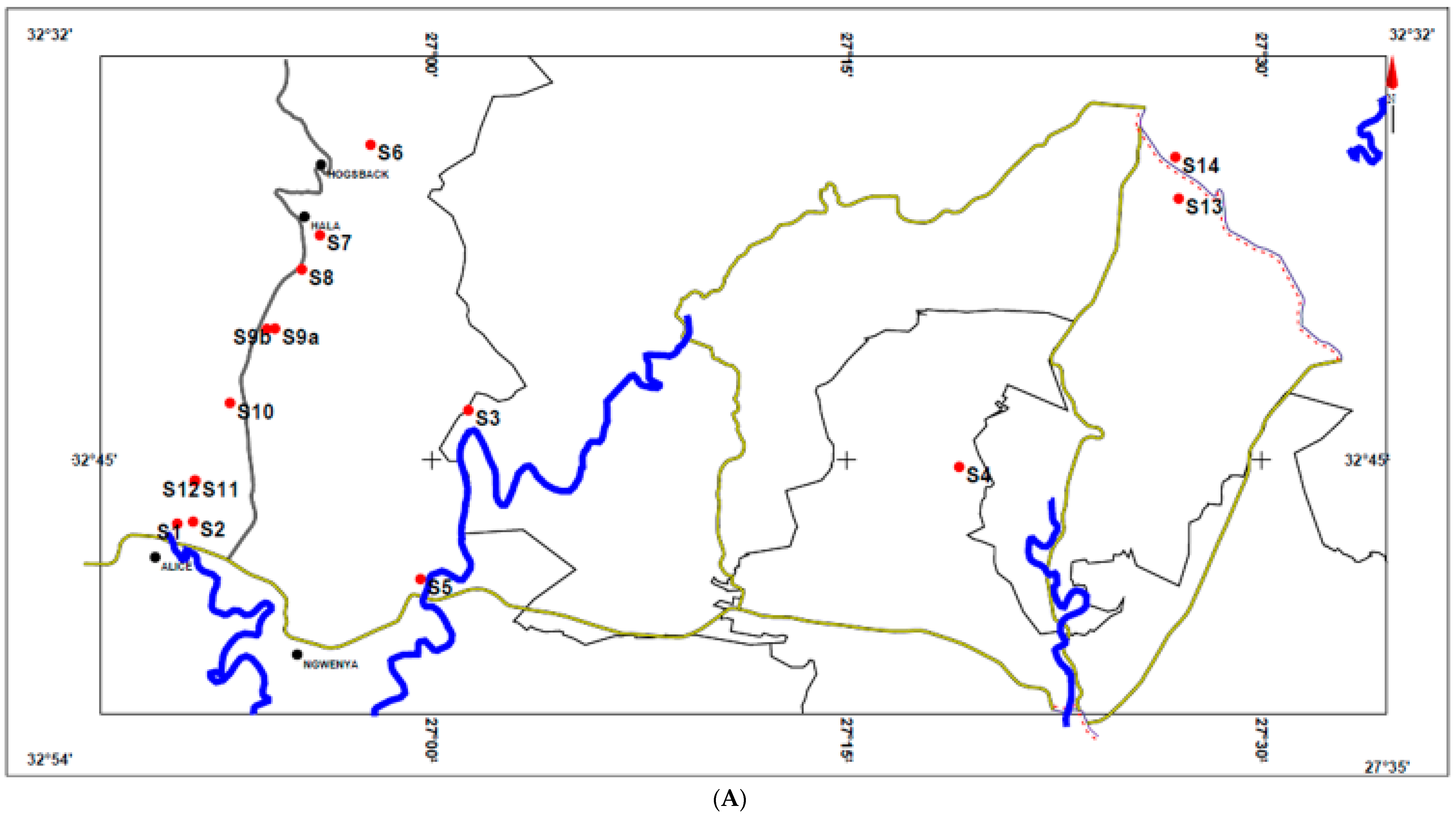
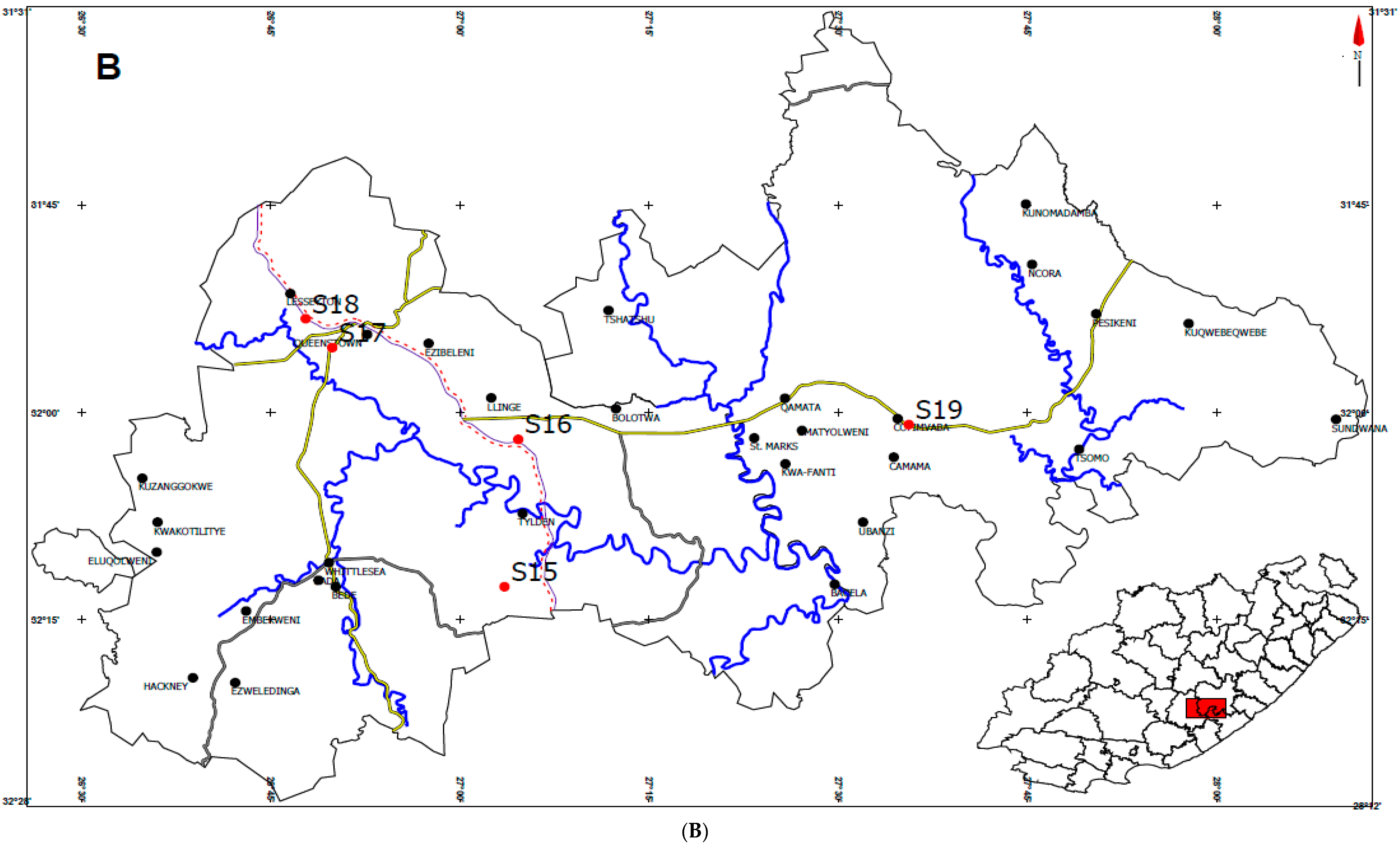
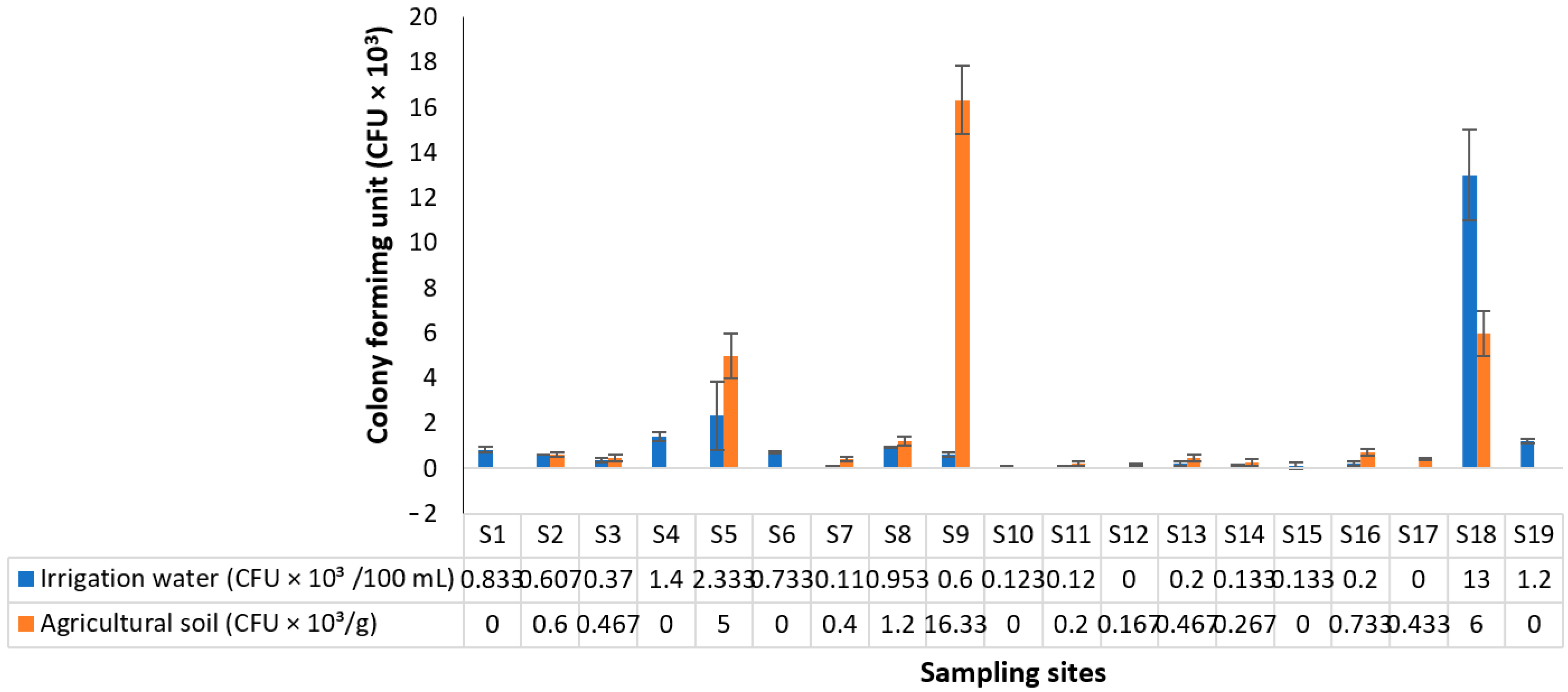
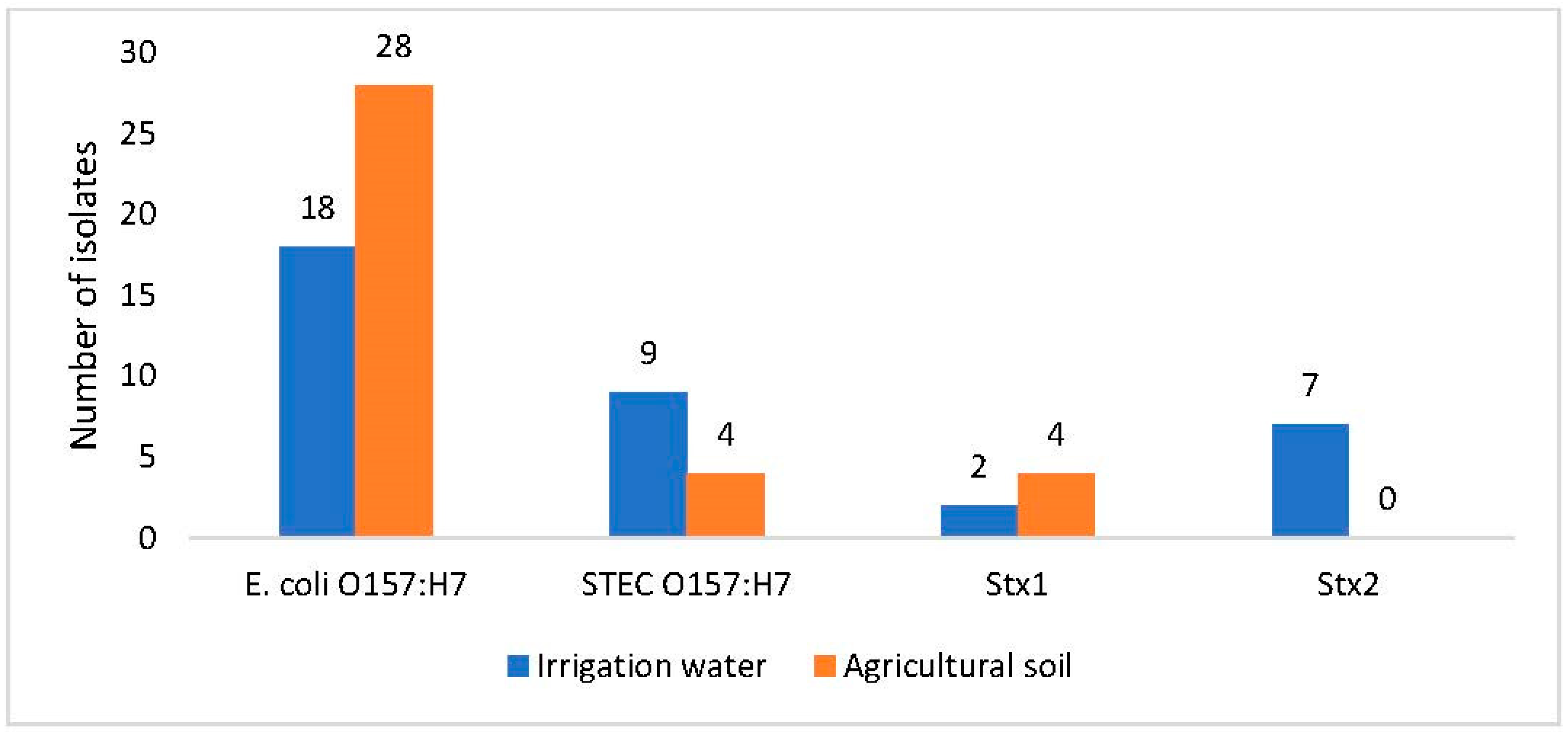
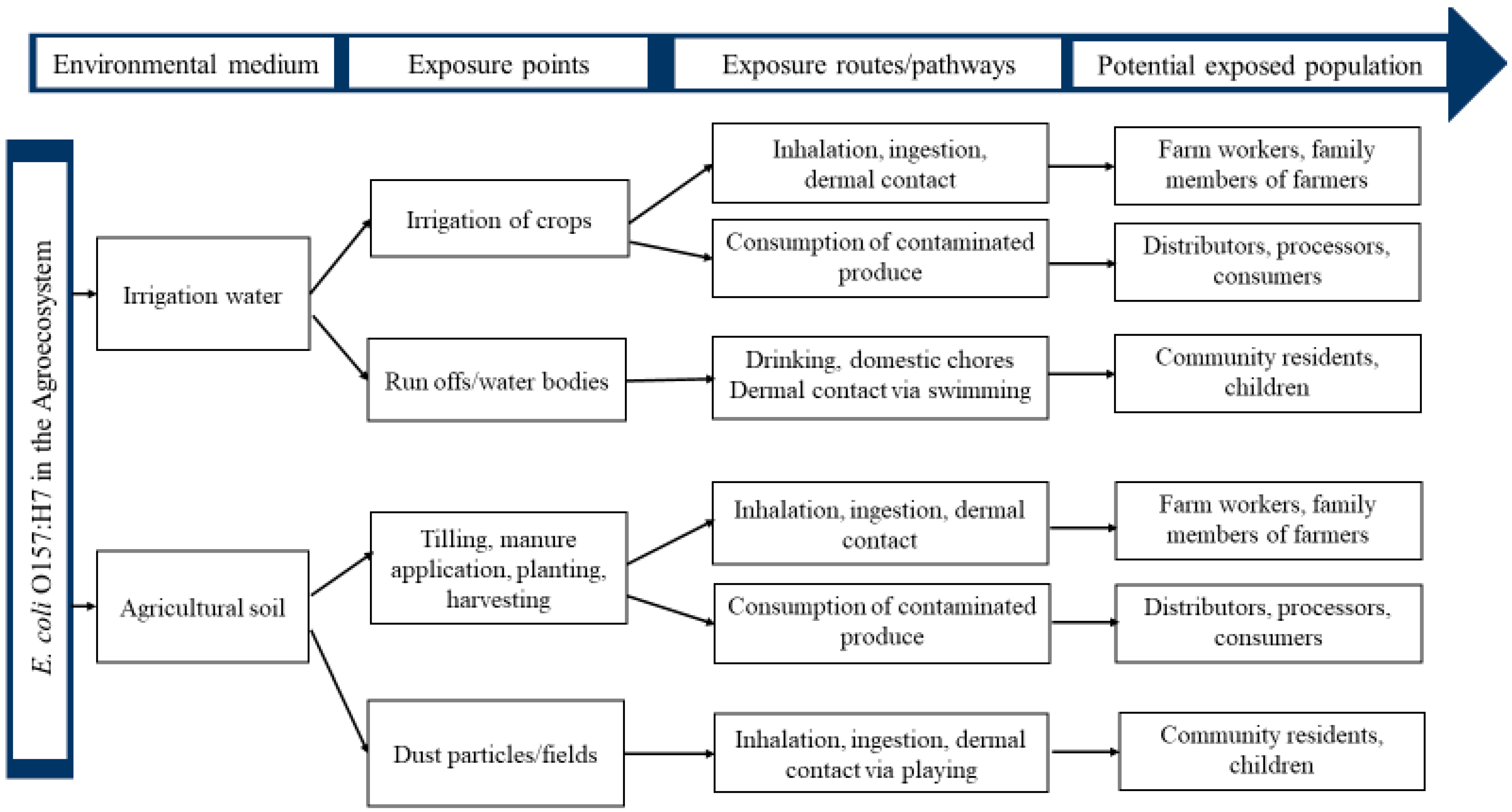
| Primer | Primer Sequence (5′-3′) | Target Genes | Amplicon Size (bp) | Reference |
|---|---|---|---|---|
| FliCH7 | F: TACCATCGCAAAAGCAACTCC | fliCH7 | 247 | [18] |
| R: GTCGGCAACGTTAGTGATACC | ||||
| RfbE | F: CTACAGGTGAAGGTGGAATGG | rfbEO157 | 327 | [21] |
| R: ATTCCTCTCTTTCCTCTGCGG | ||||
| Stx1 | F: ATAAATCGCCATTCGTTGACTAC | stx1 | 180 | [19] |
| R: AGAACGCCCACTGAGATCATC | ||||
| Stx2 | F: GGCACTGTCTGAAACTGCTCC | stx2 | 255 | [19] |
| R: TCGCCAGTTATCTGACATTCTG |
| Irrigation Water | Agricultural Soil | ||||
|---|---|---|---|---|---|
| Parameter | Data | Source | Parameter | Data | Source |
| Concentration (C) of E. coli O157:H7 (CFU/100mL) | Min: 0.000 Mean: 1.328 × 103 Max: 13.000 × 103 | This study | Concentration (C) of E. coli O157:H7 (CFU/g) | Min: 0.167 × 103 Mean: 2.482 × 103 Max: 16.333 × 103 | This study |
| Recovery efficiency (R) (%) | 83 | This study | Recovery efficiency (R) (%) | 71 | This study |
| Proportion (I) of E. coli O157:H7 capable of causing severe infection (that is STEC O157:H7) (%) | 50 | This study | Proportion (I) of E. coli O157:H7 capable of causing severe infection (that is STEC O157:H7) (%) | 14 | This study |
| Amount (M) of water ingested by adults during farming (mL/day) | 10 | [27] | Amount (M) of soil and dust ingested by adults (mg/day) | 50 | [28] |
| Amount (M) of water ingested by children during farming | Not given | Amount (M) of soil and dust ingested by children (mg/day) | 100 | [28] | |
| Parameter | Irrigation Water | Agricultural Soil | ||||
|---|---|---|---|---|---|---|
| Min | Mean | Max | Min | Mean | Max | |
| Ingestion dose (D) in adults | 0.00 | 13.28 × 103 | 130.00 × 103 | 8.33 × 103 | 124.10 × 103 | 816.67 × 103 |
| Ingestion dose (D) in children | - | - | - | 16.67 × 103 | 248.21 × 103 | 1633.33 × 103 |
| Probability of infection (Pinf) in adults (daily risk) | 0.00 | 3.30 × 10−1 | 4.70 × 10−1 | 3.80 × 10−1 | 4.30 × 10−1 | 5.20 × 10−1 |
| Probability of infection (Pinf) in children (daily risk) | - | - | - | 4.00 × 10−1 | 4.50 × 10−1 | 5.40 × 10−1 |
| Parameter | Irrigation Water | Agricultural Soil |
|---|---|---|
| Exposure (E) in adults | Min: 0.000 Mean: 8.000 × 103 Max: 78.313 × 103 | Min: 1.647 ×103 Mean: 24.470 × 103 Max: 161.030 × 103 |
| Exposure (E) in children | Not determined | Min: 3.293 × 103 Mean: 48.941 × 103 Max: 322.059 × 103 |
| Parameter | Irrigation Water | Agricultural Soil | ||||
|---|---|---|---|---|---|---|
| Min | Mean | Max | Min | Mean | Max | |
| Annual risk (Pinf/y) in adults | 0.0 | 1.0 | 1.0 | 1.0 | 1.0 | 1.0 |
| Annual risk (Pinf/y) in children | - | - | - | 1.0 | 1.0 | 1.0 |
| Annual risk of diarrheal disease (Pill) in adults | 0.0 | 25.0 × 10−2 | 25.0 × 10−2 | 25.0 × 10−2 | 25.0 × 10−2 | 25.0 × 10−2 |
| Annual risk of diarrheal disease (Pill) in children | - | - | - | 25.0 × 10−2 | 25.0 × 10−2 | 25.0 × 10−2 |
Publisher’s Note: MDPI stays neutral with regard to jurisdictional claims in published maps and institutional affiliations. |
© 2022 by the authors. Licensee MDPI, Basel, Switzerland. This article is an open access article distributed under the terms and conditions of the Creative Commons Attribution (CC BY) license (https://creativecommons.org/licenses/by/4.0/).
Share and Cite
Iwu, C.D.; Iwu-Jaja, C.J.; Okoh, A.I.; Otim, M.E.; Al Marzouqi, A.M. Estimating the Risk of Acute Gastrointestinal Disease Attributed to E. coli O157:H7 in Irrigation Water and Agricultural Soil: A Quantitative Microbial Risk Assessment. Sustainability 2022, 14, 1878. https://doi.org/10.3390/su14031878
Iwu CD, Iwu-Jaja CJ, Okoh AI, Otim ME, Al Marzouqi AM. Estimating the Risk of Acute Gastrointestinal Disease Attributed to E. coli O157:H7 in Irrigation Water and Agricultural Soil: A Quantitative Microbial Risk Assessment. Sustainability. 2022; 14(3):1878. https://doi.org/10.3390/su14031878
Chicago/Turabian StyleIwu, Chidozie Declan, Chinwe Juliana Iwu-Jaja, Anthony Ifeanyin Okoh, Michael Ekubu Otim, and Amina M. Al Marzouqi. 2022. "Estimating the Risk of Acute Gastrointestinal Disease Attributed to E. coli O157:H7 in Irrigation Water and Agricultural Soil: A Quantitative Microbial Risk Assessment" Sustainability 14, no. 3: 1878. https://doi.org/10.3390/su14031878
APA StyleIwu, C. D., Iwu-Jaja, C. J., Okoh, A. I., Otim, M. E., & Al Marzouqi, A. M. (2022). Estimating the Risk of Acute Gastrointestinal Disease Attributed to E. coli O157:H7 in Irrigation Water and Agricultural Soil: A Quantitative Microbial Risk Assessment. Sustainability, 14(3), 1878. https://doi.org/10.3390/su14031878






